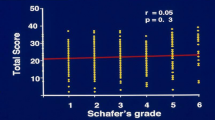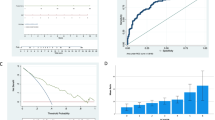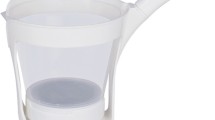Summary
The treatment of benign prostatic hyperplasia and the definition of bladder-outlet obstruction has preoccupied urologists and researchers in recent years. Bladder-outlet obstruction can be defined only by pressure-flow measurement. Various methods of analysis of pressure-flow data have been proposed. The Abrams-Griffiths nomogram is an easy method of classifying these data to distinguish between the presence or absence of obstruction. Using the values for the maximal flow and the corresponding voiding detrusor pressure a point can be plotted on the nomogram that determines whether the bladder outlet is obstructed, unobstructed, or equivocally obstructed. For those that fall in the equivocal zone, further criteria for the mean slope of the pressure-flow plot and the minimal voiding detrusor pressure are used to determine whether there is obstruction or not. The nomogram's prognostic value in predicting the outcome of prostatectomy has been studied and found to be excellent. The Abrams-Griffiths nomogram can be modified by assigning an Abrams-Griffiths number to each set of pressure-flow data. This number is easy to calculate and use and gives a continuous variable that can be used to evaluate the effects of therapy. Although the Abrams-Griffiths nomogram and number are somewhat simplistic, none of the more complex methods of pressure-flow analysis have been shown to be better predictors of treatment outcome to date.
Similar content being viewed by others
References
Abrams PH (1976) Sphincterometry in the diagnosis of male bladder outflow obstruction. J Urol 116:489–492
Abrams PH (1977) Prostatism and prostatectomy: the value of urine flow rate measurements in the pre-operative assessment for operation. J Urol 117:70–71
Abrams PH, Griffiths DJ (1979) The assessment of prostatic obstruction from urodynamic measurements and from residual urine. Br J Urol 51:129–134
Abrams PH, Skidmore R, Poole AC, Follett D (1977) The concept and measurement of bladder work. Br J Urol 49:133–138
Bates CP, Arnold EP, Griffiths DJ (1975) The nature of the abnormality in bladder neck obstruction. Br J Urol 47:651–656
Bates P, Bradley WE, Glen E, Griffiths D, Melchior H, Rowan D, Sterling A, Zinner N, Hald T (1979) The standardization of terminology of lower urinary tract function. J Urol 121:551–554
Gerstenberg TC, Andersen JT, Klarskow P, Ramirez D, Hald T (1982) High flow infravesical obstruction in men: symptomology, urodynamics and the results of surgery. J Urol 127:943–945
Griffiths DJ (1971) Hydrodynamics of male micturition. I. Therapy of steady state flow through elastic walled tubes. Med Biol Eng Comput 7:201–215
Griffiths DJ (1971) Hydrodynamics of male micturition. II. Measurements of stream parameters and urethral elasticity. Med Biol Eng Comput 9:589–596
Griffiths DJ (1973) The mechanics of the urethra and of micturition. Br J Urol 45:497–507
Griffiths DJ, Van Mastright R, Bosch R (1989) Quantification of urethral resistance and bladder function during voiding, with special reference to the effects of prostate size reduction on urethral obstruction due to benign prostatic hyperplasia. Neurourol Urodyn 8:17–27
Hald T (1989) Urodynamics in benign prostatic hyperplasia: a survey. Prostate 2 [Suppl]:69–77
Iversen P, Bruskewitz RC, Jensen KM-E, Masen PO (1983) Transurethral prostatic resection in the treatment of prostatism with high urinary flow. J Urol 129:995–997
Jensen KM-E, Jorgensen JB, Mogensen P (1988) Urodynamics in prostatism. II. Prognostic value of pressure-flow study combined with stop-flow test. Scand J Urol Nephrol [Suppl] 144:72–77
Jorgensen JB, Jensen KM-E, Bille-Brahe NE, Mogensen P (1986) Uroflowmetry in asymptomatic elderly males. Br J Urol 58:390–395
Kadow C, Howell S, Lewis P, Abrams P (1985) A flow rate nomogram of normal males over the age of %. Proceedings, ICS 15th Annual Meeting, London, pp 138–139
Layton TN, Drach GW (1981) Selectivity of peak versus average male urinary flow rates. J Urol 125:839–841
Mastrigt R, Rollema HJ (1988) Urethral resistance and urinary bladder contractility before and after transurethral resection of the prostate as determined by the computer program CLIM. Neurourol Urodyn 7:226–228
Nielsen KK, Nordling J, Hald T (1994) Critical review of the diagnosis of prostatic obstruction. Neurourol Urodyn 13:201–217
Rollema HJ, Mastrigt RV (1992) Improved indication and follow-up in transurethral resection of the prostate using the computer program CLIM: a prospective study. J Urol 148:111–116
Schäfer W (1983) Detrusor as the energy source of micturition. In: Hinman F Jr (ed) Benign prostatic hypertrophy. Springer, New York Berlin Heidelberg, pp 450–469
Schäfer W (1983) The contribution of the bladder outlet to the relation between pressure and flow rate during micturition. In: Hinman F Jr (ed) Benign prostatic hypertrophy. Springer, New York Berlin Heidelberg, pp 470–496
Schäfer W (1985) Urethral resistance? Urodynamic concepts of physiological and pathological bladder outlet function during voiding. Neurourol Urodyn 4:161–201
Schäfer W (1990) Basic principles and clinical application of advanced analysis of bladder voiding function. Urol Clin North Am 17:553–566
Schäfer W, Noppeney R, Rubben H, Lutzeyer W (1988) The value of free flow rate and pressure-flow studies in the routine investigation of BPH patients. Neurourol Urodyn 7:219–221
Schäfer W, Waterbar F, Langen PH, et al (1989) A simplified graphic procedure for detailed analysis of detrusor and outlet function during voiding. Neurourol Urodyn 8:405–407
Siroky MB, Olsson CA, Krane RJ (1979) The flow rate nomogram. I. Development. J Urol 122:665–668
Siroky MB, Olsson CA, Krane RJ (1980) The flow rate nomogram. II. Clinical correlation. J Urol 123:208–210
Smith JC (1968) Urethral resistance to micturition. Br J Urol 40:125–156
Spangberg A, Terio H, Ask P (1990) Pressure-flow studies in elderly men without voiding problems: estimation of the urethral pressure/flow relation and urethral elasticity. Neurourol Urodyn 9:123–138
Terio H, Spangberg A, Engberg A, Ask P (1989) Estimation of elastic properties in the urethral flow controlling zone by signal analysis of urodynamic pressure-flow data. Med Biol Eng Comput 27:314–321
Author information
Authors and Affiliations
Rights and permissions
About this article
Cite this article
Lim, C.S., Abrams, P. The Abrams-Griffiths nomogram. World J Urol 13, 34–39 (1995). https://doi.org/10.1007/BF00182664
Issue Date:
DOI: https://doi.org/10.1007/BF00182664




